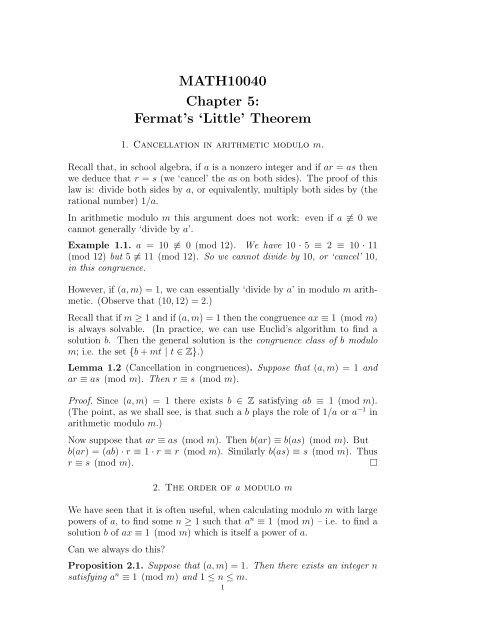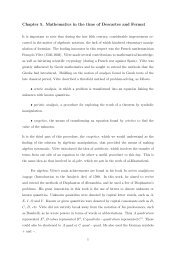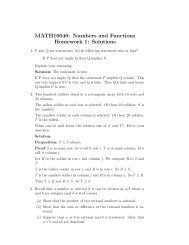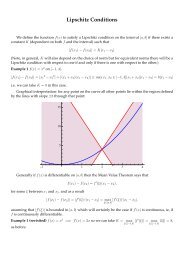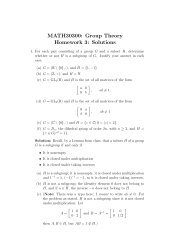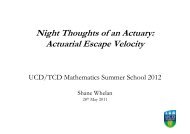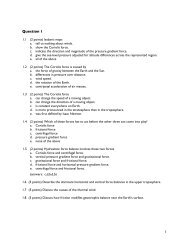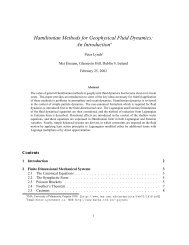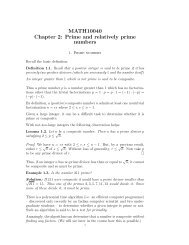MATH10040 Chapter 5: Fermat's 'Little' Theorem
MATH10040 Chapter 5: Fermat's 'Little' Theorem
MATH10040 Chapter 5: Fermat's 'Little' Theorem
Create successful ePaper yourself
Turn your PDF publications into a flip-book with our unique Google optimized e-Paper software.
<strong>MATH10040</strong><strong>Chapter</strong> 5:Fermat’s ‘Little’ <strong>Theorem</strong>1. Cancellation in arithmetic modulo m.Recall that, in school algebra, if a is a nonzero integer and if ar = as thenwe deduce that r = s (we ‘cancel’ the as on both sides). The proof of thislaw is: divide both sides by a, or equivalently, multiply both sides by (therational number) 1/a.In arithmetic modulo m this argument does not work: even if a ≢ 0 wecannot generally ‘divide by a’.Example 1.1. a = 10 ≢ 0 (mod 12). We have 10 · 5 ≡ 2 ≡ 10 · 11(mod 12) but 5 ≢ 11 (mod 12). So we cannot divide by 10, or ‘cancel’ 10,in this congruence.However, if (a, m) = 1, we can essentially ‘divide by a’ in modulo m arithmetic.(Observe that (10, 12) = 2.)Recall that if m ≥ 1 and if (a, m) = 1 then the congruence ax ≡ 1 (mod m)is always solvable. (In practice, we can use Euclid’s algorithm to find asolution b. Then the general solution is the congruence class of b modulom; i.e. the set {b + mt | t ∈ Z}.)Lemma 1.2 (Cancellation in congruences). Suppose that (a, m) = 1 andar ≡ as (mod m). Then r ≡ s (mod m).Proof. Since (a, m) = 1 there exists b ∈ Z satisfying ab ≡ 1 (mod m).(The point, as we shall see, is that such a b plays the role of 1/a or a −1 inarithmetic modulo m.)Now suppose that ar ≡ as (mod m). Then b(ar) ≡ b(as) (mod m). Butb(ar) = (ab) · r ≡ 1 · r ≡ r (mod m). Similarly b(as) ≡ s (mod m). Thusr ≡ s (mod m).□2. The order of a modulo mWe have seen that it is often useful, when calculating modulo m with largepowers of a, to find some n ≥ 1 such that a n ≡ 1 (mod m) – i.e. to find asolution b of ax ≡ 1 (mod m) which is itself a power of a.Can we always do this?Proposition 2.1. Suppose that (a, m) = 1. Then there exists an integer nsatisfying a n ≡ 1 (mod m) and 1 ≤ n ≤ m.1
2Proof. Consider the list of integers a 0 , a 1 , . . . , a m−1 , a m . There are m + 1integers in this list and each has remainder in the set {0, . . . , m − 1}. Sincethere are only m possible remainders, some two of these m + 1 numbersmust have the same remainder on division by m.Thus there exists r, s with 0 ≤ r < s ≤ m such that a r and a s have thesame remainder on division by m; i.e.a r ≡ a sLet n = s − r. So s = r + n. Thereforea r ≡ a r · a n(mod m).(mod m).Since (a r , m) = 1, we can ‘cancel’ a r on both sides, by Lemma 1.2. Thusa n ≡ 1(mod m).Definition 2.2. Suppose that (a, m) = 1. The order of a modulo m is thesmallest positive integer d with the property that a d ≡ 1 (mod m).Example 2.3. The order of 3 modulo 80 is 4 since 3 4 = 81 ≡ 1 (mod 80)but 3 1 , 3 2 , 3 3 ≢ 1 (mod 80). Here is a table of powers of 3 modulo 80:n R 80 (3 n )0 11 32 93 274 15 36 97 278 19 3.Notice that the numbers on the right repeat themselves in cycles of length 4.This is no coincidence.<strong>Theorem</strong> 2.4. Suppose that (a, m) = 1 and let d ≥ 1 be the order of amodulo m. Then a n ≡ 1 (mod m) if and only if d|n.Proof. Recall that a d ≡ 1 (mod m) and a r ≢ 1 (mod m) if 1 ≤ r < d.First suppose that d|n. Then n = dt for some integer t and hencea n = (a d ) t ≡ 1 t ≡ 1.(mod m).□
Conversely, suppose that a n ≡ 1 (mod m). We must prove that d|n. Bythe division algorithm, n = dt + r for some t, r ∈ Z with 0 ≤ r < d. Wemust prove that r = 0:3Nowa n = (a d ) t · a r ≡ 1 · a r ≡ a r (mod m)and hencea r ≡ 1 (mod m).Since r < d this forces r = 0 by the minimality of d.□Corollary 2.5. Suppose that (a, m) = 1 and let d ≥ 1 be the order of amodulo m. Then for any integers r and sa r ≡ a s (mod m) ⇐⇒ r ≡ s (mod d).Proof. We will assume, without loss of generality, that r ≤ s.Suppose that s ≡ r (mod d). Then s = r + dt for some t ≥ 0. Soa s = a r · (a d ) t ≡ a r · 1 ≡ a r(mod m).Conversely suppose that a r ≡ a s (mod m). We must prove that d|s − r.Let n = s − r. Then by Lemma 1.2 from a r ≡ a r · a n (mod m) we deduce1 ≡ a n (mod m) and hence that d|n by <strong>Theorem</strong> 2.4. □Remark 2.6. Note that the corollary says that the powers of a repeat modulom in cycles of length d. This is precisely what we observed of the powers of3 modulo 80 (where d = 4 in that case).Example 2.7. What is the order of 2 modulo 33?Solution: Let d be the oredr of 2 modulo 33.We have 2 5 = 32 ≡ −1 (mod 33). Thus 2 10 ≡ (−1) 2 ≡ 1 (mod 33).It follows from <strong>Theorem</strong> 2.4 that d|10. Thus d = 1, 2, 5 or 10. But 2, 2 2 , 2 5 ≢1 (mod 33). Thus d = 10.It follows, from <strong>Theorem</strong> 2.4 again, that2 n ≡ 1 (mod 33) ⇐⇒ 10|n.Example 2.8. The order of 7 modulo 10 is 4. (Check this!)The powers of 7 modulo 10 repeat in cycles of length 4:
4Q: What is the last digit of 7 83 ?n R 10 (7 n )0 11 72 93 34 15 76 97 38 19 7A: Since 83 ≡ 3 (mod 4), 7 83 ≡ 7 3 ≡ 3 (mod 10)..3. Fermat’s Little <strong>Theorem</strong>Remark 3.1. Recall (Homework 5, problem 5 (b)) that if p is a primenumber then ( pm)≡ 0 (mod p) if 1 ≤ m ≤ p − 1.Proposition 3.2. Let p be a prime number. Then n p ≡ n (mod p) for alln ≥ 1.Proof. We’ll prove this by induction on n. The case n = 1 is clear since1 p = 1.Suppose the result has been proved for some n ≥ 1. Then( ( ( )p p p(n + 1) p = n p + n1)p−1 + · · · + nm)m + · · · + n + 1p − 1by the Binomial <strong>Theorem</strong>.≡ n p + 0 + · · · + 0 + 1 (mod p) (see remark above)≡ n + 1 (mod p) by ind. hyp..<strong>Theorem</strong> 3.3 (Fermat’s Little <strong>Theorem</strong>). Let p be a prime and a anyinteger not divisible by p. Thena p−1 ≡ 1 (mod p)Proof. Replacing a, if necessary, by a positive number which is congruentto it modulo p, we can assume that a ≥ 1. By Proposition 3.2, we havea · a p−1 ≡ a · 1 (mod p). Since (a, p) = 1, we deduce that a p−1 ≡ 1 (mod p)by Lemma 1.2.□□
Combining Fermat’s Little <strong>Theorem</strong> with <strong>Theorem</strong> 2.4 we deduce:Corollary 3.4. Suppose that p is prime and that p ̸ |a. Let d be the orderof a modulo p. Then d|p − 1; i.e. p ≡ 1 (mod d).Example 3.5. Find the order of 10 modulo 29.Solution: Let d be the order of 10 modulo 29.29 is prime, so d|29 − 1 = 28. Thus d = 1, 2, 4, 7, 14 or 28.We eliminate all but the last:10 2 = 4 · 25 ≡ 4 · (−4) ≡ −16 (mod 29) : d ≠ 2.10 3 ≡ 10 · −16 ≡ −5 · 32 ≡ −5 · 3 ≡ −15 (mod 29).10 4 ≡ 16 2 ≡ 32 · 8 ≡ 3 · 8 ≡ 24 ≡ −5 (mod 29) : d ≠ 410 7 = 10 4 · 10 3 ≡ −5 · −15 ≡ 25 · 3 ≡ −4 · 3 ≡ −12 (mod 29) : d ≠ 7.10 14 ≡ 12 2 ≡ 36 · 4 ≡ 7 · 4 ≡ 28 · −1 (mod 29) : d ≠ 14.Thus d = 28.Thusbut29|10 28 − 1 = 99 · · · 99 } {{ }2829 ̸ | 99 · · · 99 } {{ }nif n < 28.Example 3.6. Is 2 32 + 1 = 4294967297 prime?Solution: If 2 32 + 1 is not prime, then it is divisible by a prime p
6Example 3.7. Is 2 11 − 1 = 2047 prime?Solution: Let p be a prime divisor of N = 2 11 − 1. Then 2 11 ≡ 1 (mod p).Thus the order of 2 modulo p is 11. So p is the form 11n + 1. The smallestsuch prime is 23 = 11 · 2 + 1. Dividing, we find 2047 = 23 · 89. So it iscomposite.Remark 3.8. Fermat’s Little <strong>Theorem</strong> fails in general if the modulus iscomposite; i.e. If n is composite and if (a, n) = 1 then it is not usually thecase that a n−1 ≡ 1 (mod n).For example, take n = 9 and a = 2. Then2 3 ≡ −1 (mod 9) =⇒ 2 6 ≡ 1 (mod 9) =⇒ 2 8 ≡ 2 2 ≢ 1 (mod 9).There is however, an extension of Fermat’s Little <strong>Theorem</strong>, due to Euler,which applies to composite as well as prime moduli:There is a function φ : N → N (the ‘Euler phi-function’) with the propertythat φ(p) = p − 1 when p is prime and for all m > 1 and a with (a, m) = 1we havea φ(m) ≡ 1 (mod m).In fact φ(9) = 6. So Euler’s <strong>Theorem</strong> tells us that a 6 ≡ 1 (mod 9) if 3 ̸| a.In practice, φ can be calculated from the following two facts:(1) If p is a prime number, then φ(p n ) = p n−1 (p − 1).(2) If (n, m) = 1 then φ(nm) = φ(n) · φ(m).For example, φ(100) = φ(4)φ(25) = (2 · (2 − 1)) · (5 · (5 − 1)) = 2 · 5 · 4 = 40.Example 3.9. Testing for primalityFermat’s Little <strong>Theorem</strong> is the basis for testing whether a number is primeor not. If p > 2 is a prime number, Fermat’s <strong>Theorem</strong> tells us that 2 p−1 ≡ 1(mod p). It follows that if n is any odd number and if 2 n−1 ≢ 1 (mod n)then n must be composite. In this way, we can often determine that anumber is composite without finding any factors. Indeed, there are examplesof very large numbers which are known to be composite using this test, butfor which factors cannot be found with existing computational methods.As a toy example: Suppose that we want to determine that 527 is compositewithout factoring. Easy (but tedious) calculations show that 2 40 ≡ 1(mod 527). Since 526 = 40 · 13 + 6 this gives2 256 ≡ (2 40 ) 13 · 2 6 ≡ 2 6 ≡ 64 ≢ 1 (mod 257).So 257 is composite. (In fact 257 = 17 · 31.)
Example 3.10. Use Fermat’s Little <strong>Theorem</strong> to prove that 385|n 60 − 1 if5, 7, 11 ̸ |n.Solution: Note that 385 = 5 · 7 · 11. We wish to prove that if 5, 7, 11 ̸ |nthenn 60 ≡ 1 (mod 385).Since 5, 7, 11 are pairwise relatively prime this is equivalent to showing thatn 60 ≡ 1 (mod 5) and n 60 ≡ 1 (mod 7) and n 60 ≡ 1 (mod 11)By Fermat’s Little <strong>Theorem</strong>, n 4 ≡ 1 (mod 5), and since 4|60 it follows thatn 60 ≡ 1 (mod 5).Similarly, by Fermat’s Little <strong>Theorem</strong>, n 6 ≡ 1 (mod 7), and since 6|60 itfollows that n 60 ≡ 1 (mod 7).Finally, by Fermat’s Little <strong>Theorem</strong>, n 10 ≡ 1 (mod 11), and since 10|60 itfollows that n 60 ≡ 1 (mod 11).Using the same idea as in this last example we prove the following:Lemma 3.11. Let p, q be two (distinct) odd primes. Suppose that p, q ̸ |a.Thena (p−1)(q−1)2 ≡ 1 (mod pq).Proof. Let m := (p−1)(q−1)2.Since (p, q) = 1 we just need to prove thata m ≡ 1 (mod p) and a m ≡ 1 (mod q).Since q is odd, q − 1 is even and hence q−12∈ Z. Thus p − 1| (p−1)(q−1)2= m.But a p−1 ≡ 1 (mod p) by Fermat. Hence a m ≡ 1 (mod p).Similarly (exchanging the roles of p and q) a m ≡ 1 (mod q).7□


